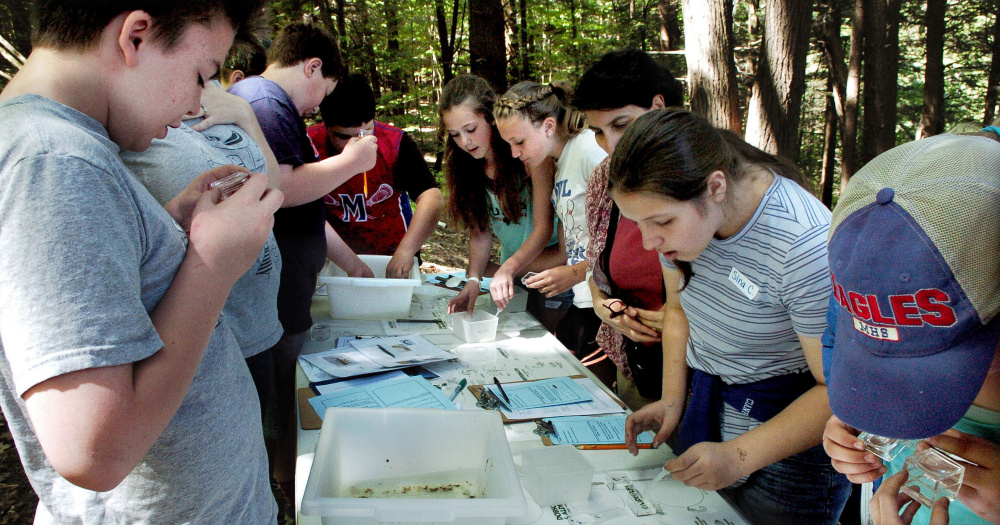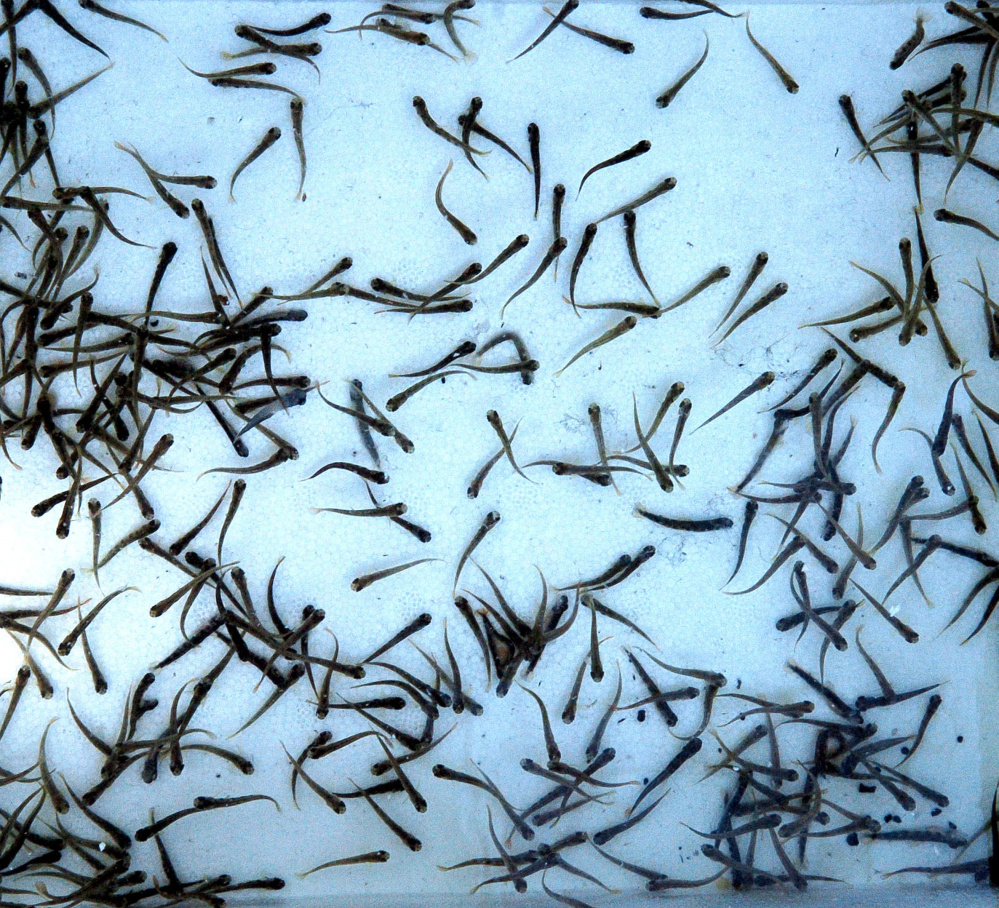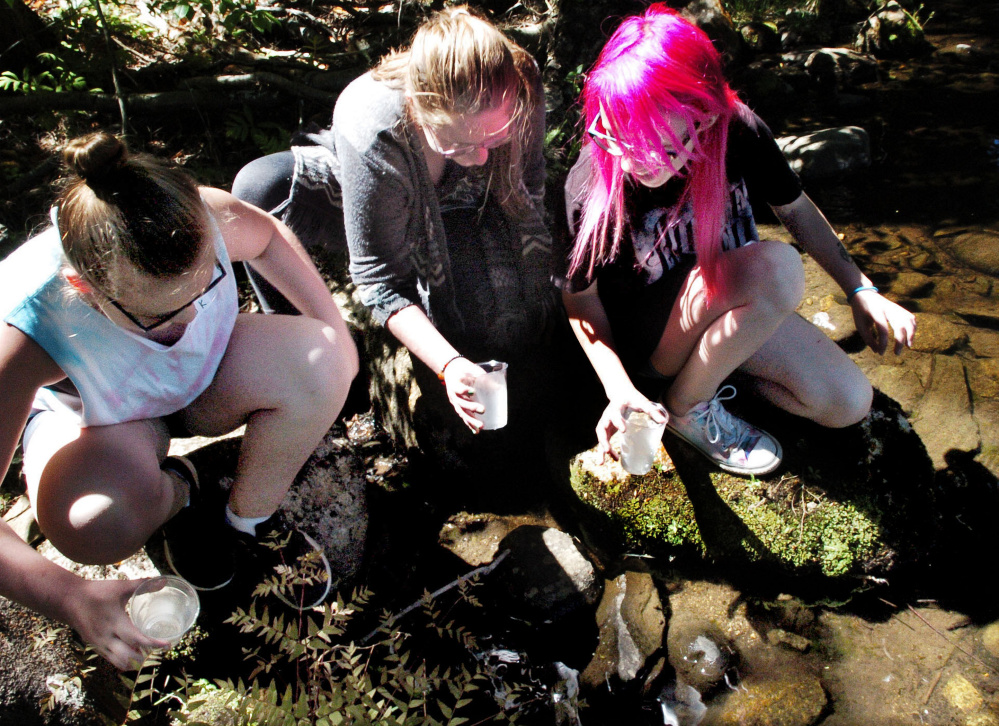OAKLAND — Middle school students walked through the nature trail next to Messalonskee Stream on Thursday morning until they came upon a small open hill beneath a blue sky and sunshine. It was a picturesque day for a hike in the woods, but the students were really there for science.
This is the fourth year in which seventh- and eighth-graders from Messalonskee Middle School have released brook trout into the stream as a science project.
The students, with the help of science teacher Amanda Ripa, have been raising brook trout since February, which they released into the stream.
Ripa previously worked for the Portland Water District, where the staff gave South Portland schools fish to do similar science projects. When she went into teaching, she decided she wanted to do that with her students.
“I’m just really passionate about getting kids outdoors and doing science outside,” said Ripa, who got an undergraduate degree in environmental science at the University of Southern Maine.
A group of seventh-graders waiting for activities to begin said they were excited to work with the brook trout and that it helped them better understand science.
Parents working as volunteers also liked the project.
“The more time they spend doing science projects, the better,” said Stacy Venable, mother of seventh-grader Phoebe.
Ripa said she gets the fish eggs from Casco Fish Hatchery in Maine. This year the students started with about 300 eggs and ended with 200 to 250 fry to put in the stream. Fry are baby fish that are still developing but can feed themselves.
Ripa keeps the fish eggs in a 20-gallon tank with a refrigerated chiller to keep the water at a low temperature. The fish develop along with the temperature and get measured in thermal units. One thermal unit is equal to one degree Celsius. When the daily thermal units reach an accumulated total of 700 units, the fish are fully developed fry that can start swimming.
Along the way in their development, the students make observations on the fish and track them. When they’re released, the best case scenario is that the fish go downstream toward the Kennebec River.
“Naturally, only a few make it out of the nest,” Ripa said, so the brook trout raised in the tank already have had better chances.
Before the students sent the fry out on their own, they divided into four groups and met at “stations” with local science professionals from Colby College, the state Department of Inland Fisheries and Wildlife, the Belgrade Regional Conservation Alliance and Project Learning Tree in the open space on the trail. Each station had a different activity led by the volunteers that got the students working with the wildlife around them. At one station along the stream was electrofishing, where students used an electric current to draw in fish. They usually catch at least one mud puppy each year, Ripa said.
Another station was led by Matthew Leahey, the education and outreach coordinator for BRCA, which partnered with Ripa in September. Nine eighth-graders gathered around Leahey as he explained their assignment: a vital signs investigation. Using cards with pictures of plants, students walked around the forested area looking for native plants, as well as plants that could be invasive species.
Other schools do similar projects in which they raise fish to release eventually, but many use salmon instead of brook trout. Ripa chose trout because the fish is an important part of the economy because of fishing, so it’s also important to the environment.
Ripa said she thinks the project will help get the students into the mindset of “being a good steward” of the land.
“The biggest reason why I do it is to connect them to the environment,” she said.
Madeline St. Amour – 861-9239
Send questions/comments to the editors.






Success. Please wait for the page to reload. If the page does not reload within 5 seconds, please refresh the page.
Enter your email and password to access comments.
Hi, to comment on stories you must . This profile is in addition to your subscription and website login.
Already have a commenting profile? .
Invalid username/password.
Please check your email to confirm and complete your registration.
Only subscribers are eligible to post comments. Please subscribe or login first for digital access. Here’s why.
Use the form below to reset your password. When you've submitted your account email, we will send an email with a reset code.